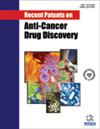Structure-Based Virtual Screening Identifying Novel FOXM1 Inhibitors as the Lead Compounds for Glioblastoma
IF 4.1
4区 医学
Q3 ONCOLOGY
Recent patents on anti-cancer drug discovery
Pub Date : 2024-05-10
DOI:10.2174/0115748928289164240426110829
引用次数: 0
Abstract
Background: Glioblastoma multiforme (GBM) is a highly heterogeneous brain tumor with limited treatment options and a poor prognosis. Cancer stem cells (CSCs) have emerged as a critical factor in GBM resistance and management, contributing to tumor growth, heterogeneity, and immunosuppression. The transcription factor FOXM1 has been identified as a key player in the progression, spread, and therapy resistance of various cancers, including GBM. Objective: In this research, the objective was to perform structure-based in silico screening with the aim of identifying natural compounds proficient in targeting the DNA-binding domain (DBD) of the FOXM1 protein. Methods: In this study, in silico tools were employed for screening a hundred naturally occurring compounds capable of targeting the FOXM1 protein. Through molecular docking analysis and pharmacokinetic profiling, five compounds were found to be promising candidates for extensive interaction with the FOXM1 protein. Further, these compounds were validated for the stability of the FOXM1-natural compound complex using molecular dynamics (MD) simulations. Results: Four compounds, such as Withaferin A, Bryophyllin A, Silybin B, Sanguinarine and Troglitazone (control compound), emerged as promising candidates with substantial interactions with FOXM1, suggesting their potential as a protein inhibitor based on molecular docking investigations. After MD simulation analysis, the FOXM1- Bryophyllin A complex was found to maintain the highest stability, and the other three ligands had moderate but comparable binding affinities over a period of 100 ns. Conclusion: This study provides valuable insights into four promising FOXM1 inhibitors that have the ability to induce senescence in GBM stem cells. These findings contribute to the development of structure-based designing strategies for FOXM1 inhibitors and innovative therapeutic approaches for the treatment of Glioblastoma.基于结构的虚拟筛选确定新型 FOXM1 抑制剂作为治疗胶质母细胞瘤的先导化合物
背景:多形性胶质母细胞瘤(GBM)是一种高度异质性脑肿瘤,治疗方案有限,预后较差。癌症干细胞(CSCs)已成为 GBM 抗药性和治疗中的关键因素,导致肿瘤生长、异质性和免疫抑制。转录因子 FOXM1 已被确定为各种癌症(包括 GBM)进展、扩散和耐药性的关键因素。研究目的本研究旨在进行基于结构的硅学筛选,目的是鉴定出能够靶向 FOXM1 蛋白 DNA 结合域 (DBD) 的天然化合物。研究方法本研究采用硅学工具筛选了一百种能够靶向 FOXM1 蛋白的天然化合物。通过分子对接分析和药代动力学分析,发现有五种化合物有望与 FOXM1 蛋白发生广泛的相互作用。此外,还利用分子动力学(MD)模拟验证了这些化合物在 FOXM1-天然化合物复合物中的稳定性。结果:根据分子对接研究,Withaferin A、Bryophyllin A、Silybin B、Sanguinarine 和 Troglitazone(对照化合物)等四种化合物成为有希望与 FOXM1 发生大量相互作用的候选化合物,表明它们具有作为蛋白质抑制剂的潜力。经过 MD 模拟分析后发现,FOXM1-苦参碱 A 复合物保持了最高的稳定性,其他三种配体在 100 ns 的时间内具有中等但相当的结合亲和力。结论本研究为四种有前景的 FOXM1 抑制剂提供了宝贵的见解,这些抑制剂具有诱导 GBM 干细胞衰老的能力。这些发现有助于开发基于结构的 FOXM1 抑制剂设计策略和治疗胶质母细胞瘤的创新疗法。
本文章由计算机程序翻译,如有差异,请以英文原文为准。
求助全文
约1分钟内获得全文
求助全文
来源期刊
CiteScore
4.50
自引率
7.10%
发文量
55
审稿时长
3 months
期刊介绍:
Aims & Scope
Recent Patents on Anti-Cancer Drug Discovery publishes review and research articles that reflect or deal with studies in relation to a patent, application of reported patents in a study, discussion of comparison of results regarding application of a given patent, etc., and also guest edited thematic issues on recent patents in the field of anti-cancer drug discovery e.g. on novel bioactive compounds, analogs, targets & predictive biomarkers & drug efficacy biomarkers. The journal also publishes book reviews of eBooks and books on anti-cancer drug discovery. A selection of important and recent patents on anti-cancer drug discovery is also included in the journal. The journal is essential reading for all researchers involved in anti-cancer drug design and discovery. The journal also covers recent research (where patents have been registered) in fast emerging therapeutic areas/targets & therapeutic agents related to anti-cancer drug discovery.

 求助内容:
求助内容: 应助结果提醒方式:
应助结果提醒方式:


